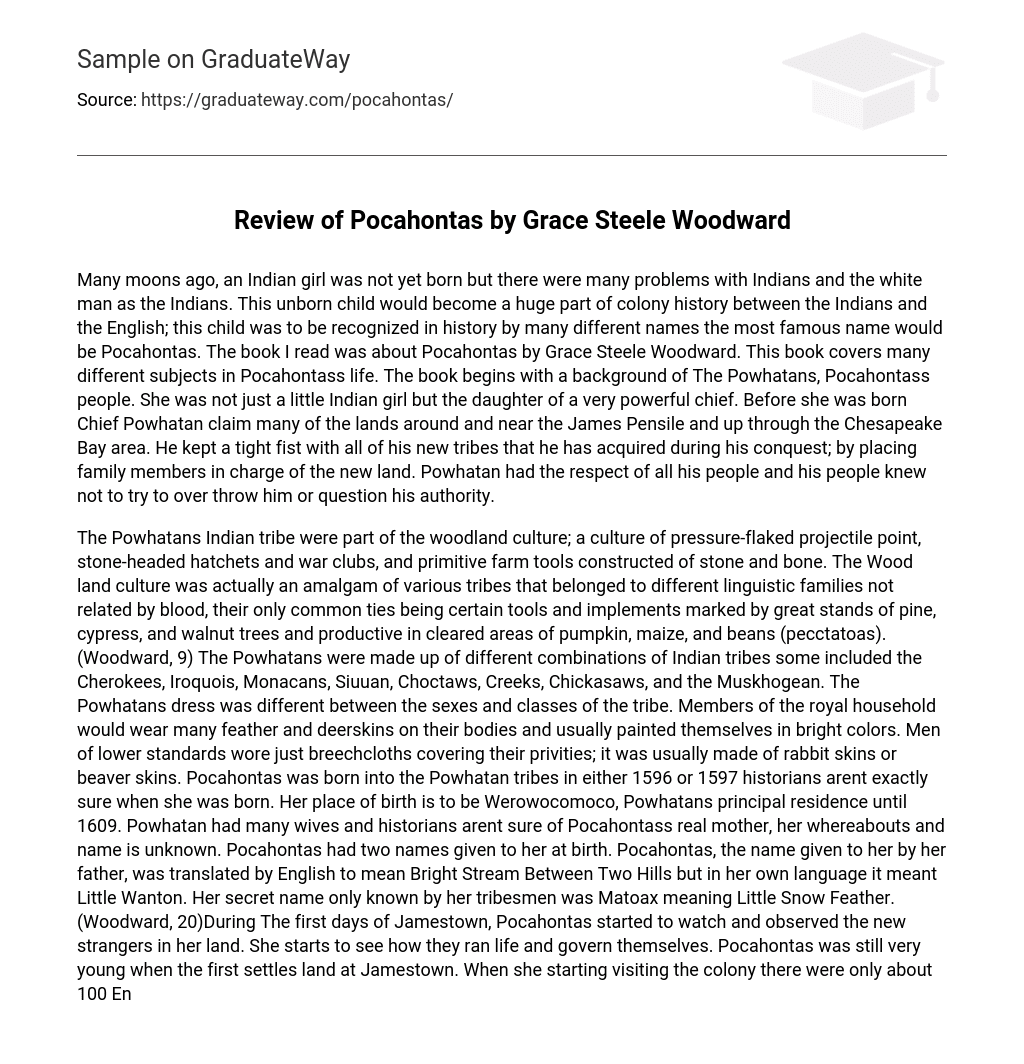The book “Pocahontas” by Grace Steele Woodward examines the life of an unborn Indian girl who would have a significant impact on the colonies’ history, particularly in the relationship between Indians and the English. This girl, later known as Pocahontas, was Chief Powhatan’s daughter. Chief Powhatan was a powerful leader of The Powhatans. The book explores The Powhatans’ background and their territory, which stretched from the James Peninsula to the Chesapeake Bay area. Chief Powhatan effectively governed his acquired lands by placing family members in positions of authority and earning his people’s respect.
The Powhatans Indian tribe belonged to the woodland culture, which was characterized by pressure-flaked projectile point, stone-headed hatchets and war clubs, and primitive farm tools made of stone and bone. The Woodland culture was actually a combination of tribes from different linguistic families, who were not related by blood. The only commonality between them was the use of certain tools and implements found in areas with pine, cypress, and walnut trees, as well as cleared areas where they grew pumpkin, maize, and beans. The Powhatans consisted of various combinations of Indian tribes, including the Cherokees, Iroquois, Monacans, Siuuan, Choctaws, Creeks, Chickasaws, and the Muskhogean. The tribe’s attire varied depending on sex and social class. Members of the royal household adorned themselves with feathers and deer skins and often painted their bodies in vibrant colors.
Men of lower standards wore only breechcloths to cover their privities, which were usually made of rabbit skins or beaver skins. Pocahontas, born in 1596 or 1597, was a member of the Powhatan tribes. Her birthplace is believed to be Werowocomoco, the principal residence of Powhatan until 1609. As Powhatan had multiple wives, historians are uncertain about the identity and whereabouts of Pocahontas’s real mother. Pocahontas was given two names at birth. Her father called her Pocahontas, which English translates as “Bright Stream Between Two Hills,” but in her language it meant “Little Wanton.” Her tribesmen knew her by her secret name, Matoax, meaning “Little Snow Feather.” During the early days of Jamestown, Pocahontas observed and closely watched the new strangers in her land. She observed their way of life and governance. Pocahontas was still very young when the first settlers arrived at Jamestown.
When she first visited the colony, there were around 100 Englishmen, the Anglican chaplain, and twelve workers. Pocahontas was particularly fascinated by Captain John Smith, a young and adventurous 26-year-old. During their journey to Jamestown, Smith was arrested by Captain Newport for inciting mutiny among some crew members on the Susan Constant ship. However, Smith was released upon reaching Jamestown. It was not until June 10 that he could swear allegiance to King James and participate in council meetings, as he was cleared of all charges. Pocahontas found John Smith to be the most approachable of all the English colonists. He actively tried to learn the Powhatan language and facilitate communication between the Indians and the colonists. Moreover, Smith recognized that the Indians could provide assistance to the colonists in times of need.
Pocahontas’s father had little interest in conversing with the white man and feared they would bring ruin to his empire and region. He strongly desired to capture and execute John Smith by clubbing him, but Pocahontas intervened by shielding Smith with her body to save him. Although this temporarily altered her father’s attitude, he remained uncertain about the white men’s intentions. Shortly after Smith left Jamestown, conflicts with the Indians escalated. Since few Englishmen understood the Indian language, some believed all hope was lost. However, Lord De La Warr proposed abducting Indian children and bringing them to England to learn English customs. This suggestion did not sit well with other council members. Nonetheless, the English took Pocahontas from Powhatan and educated her as an English lady, dressing her in their clothing and instructing her in Church practices. By spring of 1914, she had converted to the Church of England and received the name Rebecca.
On April 5,1614, Pocahontas married John Rolfe and relocated to England. As Rebecca Rolfe, she went to the English court and met the king and queen of England, becoming an international figure in promoting peace between Indians and English people. In 1615, she gave birth to a son named Thomas. However, on March 21, 1616, the planned day for her return to Virginia, she passed away from pneumonia or possibly tuberculosis and was buried on that same day. Despite her death, the peace between England and Indians remained intact for many years.
This book offers informative insights into Pocahontas’s life; although it could have focused more on her instead of Jamestown events. Nonetheless, I understand that their stories were interconnected with Pocahontas’s existence. Without the colonization of Jamestown, we would not have been acquainted with Pocahontas and our present may have been different. I recommend this book to anyone interested in Indian history and Pocahontas.
Bibliography: Woodward, Grace Steele. Pocahontas. New York, NY: MJF Books Fine Communication. 1969





